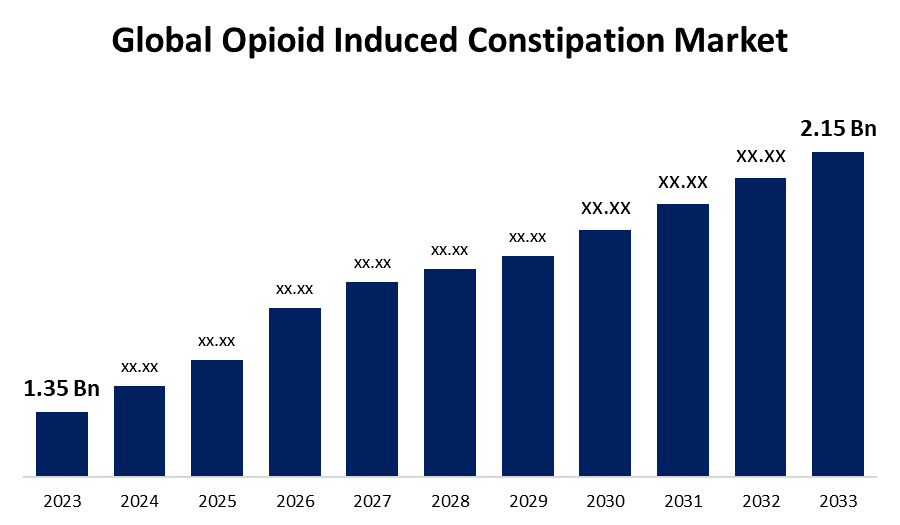Global Opioid Induced Constipation Market Size, Share, and COVID-19 Impact Analysis, By Prescription Type (Over the counter, and Prescription), By Drug Class (Mu-opioid Receptor Antagonists, Chloride Channel-2 Activators, and Others), By Distribution Channel (Hospital Pharmacies, Online Providers, and Drug Stores and Retail Pharmacies), and By Region (North America, Europe, Asia-Pacific, Latin America, Middle East, and Africa), Analysis and Forecast 2023 - 2033
Industry: HealthcareGlobal Opioid Induced Constipation Market Insights Forecasts to 2033
- The Global Opioid Induced Constipation Market Size was Valued at USD 1.35 Billion in 2023.
- The Market Size is Growing at a CAGR of 4.76% from 2023 to 2033.
- The Worldwide Opioid Induced Constipation Market Size is Expected to Reach USD 2.15 Billion by 2033.
- Asia-Pacific is Expected to Grow the fastest during the forecast period.

Get more details on this report -
The Global Opioid Induced Constipation Market Size is Anticipated to Exceed USD 2.15 Billion by 2033, Growing at a CAGR of 4.76% from 2023 to 2033.
Market Overview
Opioid-induced constipation is a frequent adverse event that is caused by receiving long-term therapy of opioids for chronic pain therapy. About 40-60% of patients receiving opioids are suffering from opioid-induced constipation. It may be induced immediately and gradually during opioid therapy. The opioid receptors decrease the neurotransmitter release in the GI tract leading to inhibition of gastric emptying and peristalsis showing symptoms of constipation like stool straining and incomplete defecation. In association with constipation, patients may also develop other GI side effects like nausea, vomiting, bloat, abdominal pain, and straining. Thus, laxatives are included in opioid therapy regimes to prevent OIC. The significantly increasing side effects in the digestive system due to opioids and growing demand for OIC drugs and treatment lead to escalating the growth of the opioid-induced constipation drugs market. The growing R&D focus on precision medicine and therapies to enhance the efficacy of OIC treatment leads to significant advancement in the field. The development of medicine with well-tolerated, enhancing patient compliance and satisfaction and safety profiles and personalized medication leads to market growth of the opioid-induced drug market. Currently, R&D aims to identify biomarkers and patient characteristics to influence the specificity of OIC drug treatment.
Report Coverage
This research report categorizes the market for the global opioid induced constipation market based on various segments and regions forecasts revenue growth and analyzes trends in each submarket. The report analyses the key growth drivers, opportunities, and challenges influencing the global opioid induced constipation market. Recent market developments and competitive strategies such as expansion, product launch, and development, partnership, merger, and acquisition have been included to draw the competitive landscape in the market. The report strategically identifies and profiles the key market players and analyses their core competencies in each sub-segment of the global opioid induced constipation market.
Global Opioid Induced Constipation Market Report Coverage
| Report Coverage | Details |
|---|---|
| Base Year: | 2023 |
| Market Size in 2023: | USD 1.35 Billion |
| Forecast Period: | 2023-2033 |
| Forecast Period CAGR 2023-2033 : | 4.76% |
| 2033 Value Projection: | USD 2.15 Billion |
| Historical Data for: | 2019-2022 |
| No. of Pages: | 200 |
| Tables, Charts & Figures: | 120 |
| Segments covered: | By Prescription Type, By Drug Class, By Distribution Channel, By Region and COVID-19 Impact Analysis. |
| Companies covered:: | AstraZeneca plc, Merck & Co Inc., GlaxoSmithKline, Novartis AG, Sanofi, Bayer AG, Atlantis Consumer Healthcare Inc., Bausch Health Companies Inc., Cumberland Pharmaceuticals Inc., Shionogi & Co., Ltd., Valinor Pharma LLC, Mallinckrodt Pharmaceuticals, Ironwood Pharmaceuticals, Daiichi Sankyo Co, S.L.A. Pharma, Mundipharma International Ltd., and other key vendors. |
| Pitfalls & Challenges: | COVID-19 Empact, Challenge, Future, Growth, & Analysis |
Get more details on this report -
Driving Factors
The rising innovation and advancement in technology for the manufacturing of drugs is likely to drive the market. The growing demand for novel drugs for OIC due to rising prevalence of chronic pain in adults surged to enhance the market growth of opioid induced constipation. The rising awareness and educating people via health apps among the general population likely to expand market in near future due to available treatment options and adoption of methylnaltrexone in the form of SC parenteral.
Restraining Factors
Opioid induced constipation had significantly higher healthcare costs due to more frequent and longer emergency department visits, home visits, nursing home visits, other outpatient care, inpatient care, laboratory services, and pharmacy services. The overuse of OIC drugs shows significant side effects that significantly hamper the market.
Market Segmentation
The Global Opioid Induced Constipation Market share is classified into prescription type, drug class, and distribution channel
- The prescription segment is expected to hold the largest share of the global opioid induced constipation market during the forecast period.
Based on the prescription type, the global opioid induced constipation market is divided into over the counter, and prescription. Among these, the prescription segment is expected to hold the largest share of the opioid induced constipation market during the forecast period. Prescription drugs have higher efficacy and potency than OTC drugs as they directly attach to receptors throughout the nervous system. These drugs include oxycodone (OxyContine), Hydrocodone (Zohydro ER), Codeine, and Morphine.
- The mu-opioid receptor antagonists segment is expected to grow at the fastest pace in the global opioid induced constipation market during the forecast period.
Based on the drug class, the global opioid induced constipation market is divided into mu-opioid receptor antagonists, chloride channel-2 activators, and others. Among these, the mu-opioid receptor antagonists segment is expected to grow at the fastest pace in the global opioid induced constipation market during the forecast period. Mu-opioid drugs are the most suitable for different OIC symptoms and are readily accessible in the market. Methylnaltrexone (Relistor), Naldemedine (Symproic), Naloxegol (Movantik), and Alvimopan (Entereg) are some of the examples of drugs targeting mu-opioid receptor.
- The drug stores and retail pharmacies segment is expected to grow at the greatest pace in the global opioid induced constipation market during the forecast period.
Based on the distribution channel, the global opioid induced constipation market is divided into hospital pharmacies, online providers, and drug stores and retail pharmacies. Among these, the drug stores and retail pharmacies segment is expected to grow at the greatest pace in the global opioid induced constipation market during the forecast period. The dominance of hospitals for opioid usage is due to the accessibility of therapy and clinical settings. Additionally, hospitals may collaborate with pharmaceutical companies to ensure a steady supply of fibrate drugs and gain access to clinical trials or special formulations.
Regional Segment Analysis of the Global Opioid Induced Constipation Market
- North America (U.S., Canada, Mexico)
- Europe (Germany, France, U.K., Italy, Spain, Rest of Europe)
- Asia-Pacific (China, Japan, India, Rest of APAC)
- South America (Brazil and the Rest of South America)
- The Middle East and Africa (UAE, South Africa, Rest of MEA)
North America is anticipated to hold the largest share of the global opioid induced constipation market over the predicted timeframe.

Get more details on this report -
North America is anticipated to hold the largest share of the global opioid induced constipation market over the predicted timeframe. AstraZeneca, Merck & Co., Shionogi & Co., Mallinckrodt Plc., and Bausch Health Companies Inc. are some of the key market players in the region responsible for driving the market. Lubiprostone, Methylnaltrexone, Naldemedine, and Naloxegol are the prescribed OIC medications currently approved by the United States Food and Drug Administration. The rising prevalence of cancer in the region and increasing healthcare expenditure are responsible for enhancing the market demand for opioid-induced constipation. The organization of education camps and presence of a well-established healthcare infrastructure, and the rise in the adoption rate of parenteral medication for OIC are expected to drive the market.
Asia-Pacific is expected to grow at the fastest pace in the opioid-induced constipation market during the forecast period. The increasing prevalence of cancer driving the market growth in the region. In India, the the increased utilization of opioids as pain relievers is driving the market. According to the National Library of Medicine 2020, India accounts for 2.1% population consuming opioids for pain relief. According to an article published in the Japanese Journal of Clinical Oncology 2020, opioid used for lung cancer pain management has a 59% chance for OIC. Thus all these factors create profitable opportunities for the OIC market.
Competitive Analysis:
The report offers the appropriate analysis of the key organizations/companies involved within the global opioid induced constipation along with a comparative evaluation primarily based on their product offering, business overviews, geographic presence, enterprise strategies, segment market share, and SWOT analysis. The report also provides an elaborative analysis focusing on the current news and developments of the companies, which includes product development, innovations, joint ventures, partnerships, mergers & acquisitions, strategic alliances, and others. This allows for the evaluation of the overall competition within the market.
List of Key Companies
- AstraZeneca plc
- Merck & Co Inc.
- GlaxoSmithKline
- Novartis AG
- Sanofi
- Bayer AG
- Atlantis Consumer Healthcare Inc.
- Bausch Health Companies Inc.
- Cumberland Pharmaceuticals Inc.
- Shionogi & Co., Ltd.
- Valinor Pharma LLC
- Mallinckrodt Pharmaceuticals
- Ironwood Pharmaceuticals
- Daiichi Sankyo Co
- S.L.A. Pharma
- Mundipharma International Ltd.
- Others
Key Target Audience
- Market Players
- Investors
- End-users
- Government Authorities
- Consulting And Research Firm
- Venture capitalists
- Value-Added Resellers (VARs)
Recent Developments
- In December 2021, Symproic Tablets 0.2mg was approved for the treatment of opioid-induced constipation in adult patients in Taiwan. Symproic is a peripherally-acting mu-opioid receptor antagonist developed by Shionogi.
Market Segment
This study forecasts revenue at global, regional, and country levels from 2020 to 2033. Spherical Insights has segmented the Global Opioid Induced Constipation Market based on the below-mentioned segments:
Global Opioid Induced Constipation Market, By Prescription Type
- Over the counter
- Prescription
Global Opioid Induced Constipation Market, By Drug Class
- Mu-opioid Receptor Antagonists
- Chloride Channel-2 Activators
- Others
Global Opioid Induced Constipation Market, By Distribution Channel
- Hospital Pharmacies
- Online Providers
- Drug Stores and Retail Pharmacies
Global Opioid Induced Constipation Market, By Region
- North America
- US
- Canada
- Mexico
- Europe
- Germany
- Uk
- France
- Italy
- Spain
- Russia
- Rest of Europe
- Asia Pacific
- China
- Japan
- India
- South Korea
- Australia
- Rest of Asia Pacific
- South America
- Brazil
- Argentina
- Rest of South America
- Middle East & Africa
- UAE
- Saudi Arabia
- Qatar
- South Africa
- Rest of the Middle East & Africa
Frequently Asked Questions (FAQ)
-
1. Which are the key companies that are currently operating within the market?AstraZeneca plc, Merck & Co Inc., GlaxoSmithKline, Novartis AG, Sanofi, Bayer AG, Atlantis Consumer Healthcare Inc., Bausch Health Companies Inc., Cumberland Pharmaceuticals Inc., Shionogi & Co., Ltd., Valinor Pharma LLC, Mallinckrodt Pharmaceuticals, Ironwood Pharmaceuticals, Daiichi Sankyo Co, S.L.A. Pharma, Mundipharma International Ltd, and Others.
-
2. What is the size of the global opioid induced constipation market?The Global Opioid Induced Constipation Market is expected to grow from USD 1.35 Billion in 2023 to USD 2.15 Billion by 2033, at a CAGR of 4.76% during the forecast period 2023-2033.
-
3. Which region is holding the largest share of the market?North America is anticipated to hold the largest share of the global opioid induced constipation market over the predicted timeframe.
Need help to buy this report?